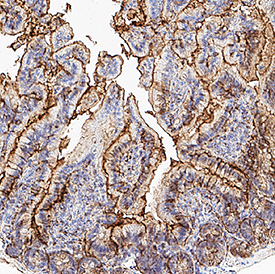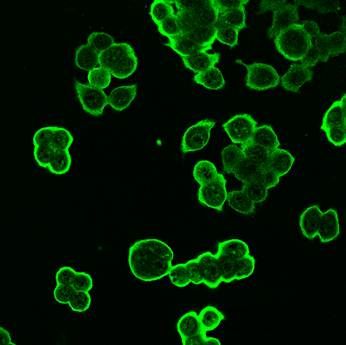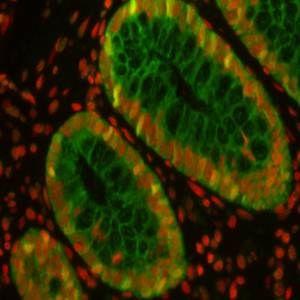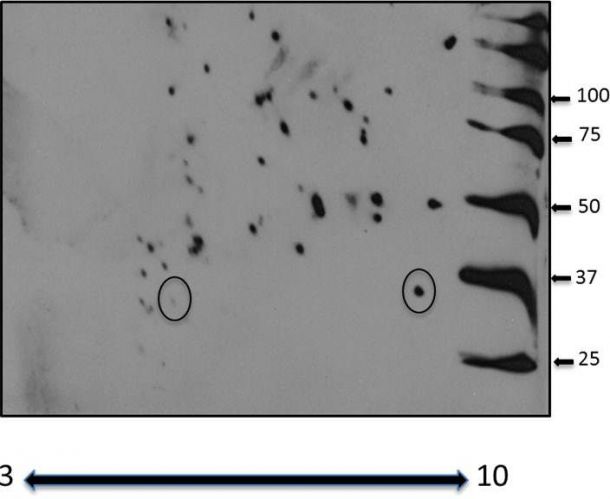Mouse Galectin-4 Antibody Summary
Ala2-Ile326
Accession # Q8K419
Applications
Please Note: Optimal dilutions should be determined by each laboratory for each application. General Protocols are available in the Technical Information section on our website.
Scientific Data
 View Larger
View Larger
Detection of Galectin‑4 in Mouse Intestine. Galectin‑4 was detected in immersion fixed paraffin-embedded sections of Mouse Intestine using Goat Anti-Mouse Galectin‑4 Antigen Affinity-purified Polyclonal Antibody (Catalog # AF2128) at 3 µg/mL for 1 hour at room temperature followed by incubation with the Anti-Goat IgG VisUCyte™ HRP Polymer Antibody (Catalog # VC004). Before incubation with the primary antibody, tissue was subjected to heat-induced epitope retrieval using VisUCyte Antigen Retrieval Reagent-Basic (Catalog # VCTS021). Tissue was stained using DAB (brown) and counterstained with hematoxylin (blue). Specific staining was localized to cytoplasm and plasma membrane in intestinal epithelial cells. View our protocol for IHC Staining with VisUCyte HRP Polymer Detection Reagents.
Reconstitution Calculator
Preparation and Storage
- 12 months from date of receipt, -20 to -70 °C as supplied.
- 1 month, 2 to 8 °C under sterile conditions after reconstitution.
- 6 months, -20 to -70 °C under sterile conditions after reconstitution.
Background: Galectin-4
Galectins are a family of carbohydrate-binding proteins with specificity for N-acetyl-lactosamine-containing glycoproteins. At least 14 mammalian galectins share structural similarities in their carbohydrate recognition domains (CRD), forming three groups often termed prototype (one CRD), tandem-repeat (two CRDs) and chimeric (one CRD, unique N-terminus) (1, 2). All lack classical signal peptides, but are present and active both within and outside of the cell. Galectins are involved in cell adhesion, migration, survival, and apoptosis, and are often up- or down-regulated in cancer (1-3). Galectin-4 is a 36 kDa tandem-repeat galectin found throughout the gastrointestinal tract, but also present in well-differentiated breast and liver carcinomas (3, 4). Each CRD binds a different set of carbohydrate groups, including those found on erythrocyte blood group antigens (3, 5). CRD1 also binds cholesterol 3-sulfate and other sulfatides, which are concentrated within lipid raft membrane microdomains (6, 7). Endocytosed Galectin-4 is thought to play a role in forming the rafts, delivering them to the intestinal apical membrane, and stabilizing highly detergent-resistant "superrafts" (7-9). Human Galectin-4 shares 76%, 77%, 78%, and 80% amino acid (aa) identity with mouse, rat, bovine, and porcine Galectin-4, respectively, with the highest identity occurring within the CRDs. A potential splice variant begins at aa 132 and lacks most of the first CRD (10). Galectin-4 expression is concentrated within microvilli in the gastrointestinal epithelium, where it can interact with CD3 and bind activated T cells in the lamina propria during intestinal inflammation (11, 12). Either pro- or anti-inflammatory activity has been shown, depending on the mouse model used. Galectin-4 can also bind lung, spleen, and kidney macrophages, although its expression is normally low in these tissues (5).
- Yang, R-Y. et al. (2008) Expert Rev. Mol. Med. 10:e17.
- Elola, M.T. et al. (2007) Cell. Mol. Life Sci. 64:1679.
- Huflejt, M.E. and H. Leffler (2004) Glycoconj. J. 20:247.
- Recreche, H. et al. (1997) Eur. J. Biochem. 248:225.
- Markova, V. et al. (2006) Int. J. Mol. Med. 18:65.
- Ideo, H. et al. (2007) J. Biol. Chem. 282:21081.
- Delacour, D. et al. (2005) J. Cell Biol. 169:491.
- Braccia, A. et al. (2003) J. Biol. Chem. 278:15679.
- Stechly, L. et al. (2009) Traffic 10:438.
- Entrez accession # EAW56820.
- Hokama, A. et al. (2004) Immunity 20:681.
- Paclik, D. et al. (2008) PLoS ONE 3:e2629.
Product Datasheets
Citation for Mouse Galectin-4 Antibody
R&D Systems personnel manually curate a database that contains references using R&D Systems products. The data collected includes not only links to publications in PubMed, but also provides information about sample types, species, and experimental conditions.
1 Citation: Showing 1 - 1
-
Brain glycolipids suppress T helper cells and inhibit autoimmune demyelination.
Authors: Mycko M, Sliwinska B, Cichalewska M, Cwiklinska H, Raine C, Selmaj K
J Neurosci, 2014-06-18;34(25):8646-58.
Species: Mouse
Sample Types: Whole Cells
Applications: Neutralization
FAQs
No product specific FAQs exist for this product, however you may
View all Antibody FAQsReviews for Mouse Galectin-4 Antibody
Average Rating: 4.7 (Based on 3 Reviews)
Have you used Mouse Galectin-4 Antibody?
Submit a review and receive an Amazon gift card.
$25/€18/£15/$25CAN/¥75 Yuan/¥2500 Yen for a review with an image
$10/€7/£6/$10 CAD/¥70 Yuan/¥1110 Yen for a review without an image
Filter by:
This antibody is as good as the monoclonal antibody from R&D.
Specificity: Specific
Sensitivity: Reasonably sensitive
Buffer: PBS
Dilution: 1:1000
Very specific, Red is propidium iodide the nuclear stain.
Specificity: Specific
Sensitivity: Reasonably sensitive
Buffer: PBS
Dilution: 1:500
Although there were mutliple bands, the one circled are galectin-4, the others are interactors isolated on a 2D gel. Using human cell lysates in 2D buffer.
Specificity: Specific
Sensitivity: Sensitive
Buffer: BSA
Dilution: 1:1000




